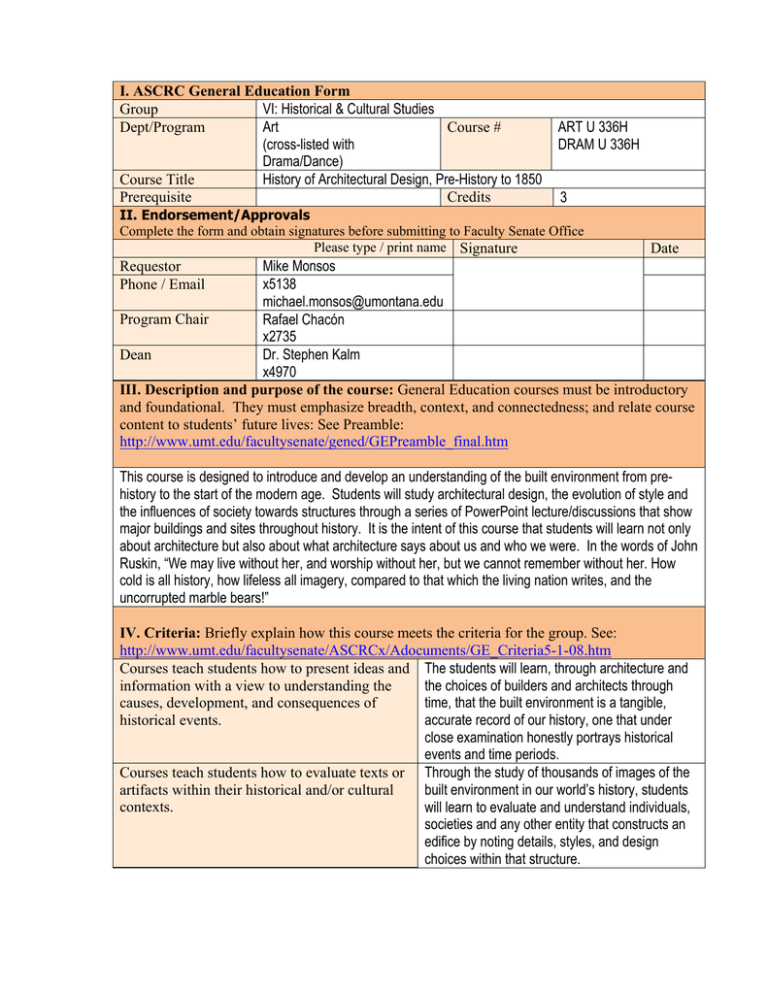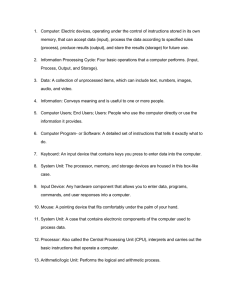I. ASCRC General Education Form VI: Historical & Cultural Studies Group Art
advertisement

I. ASCRC General Education Form Group VI: Historical & Cultural Studies Dept/Program Course # Art (cross-listed with Drama/Dance) Course Title History of Architectural Design, Pre-History to 1850 Prerequisite Credits ART U 336H DRAM U 336H 3 II. Endorsement/Approvals Complete the form and obtain signatures before submitting to Faculty Senate Office Please type / print name Signature Date Mike Monsos x5138 michael.monsos@umontana.edu Program Chair Rafael Chacón x2735 Dean Dr. Stephen Kalm x4970 III. Description and purpose of the course: General Education courses must be introductory and foundational. They must emphasize breadth, context, and connectedness; and relate course content to students’ future lives: See Preamble: http://www.umt.edu/facultysenate/gened/GEPreamble_final.htm Requestor Phone / Email This course is designed to introduce and develop an understanding of the built environment from prehistory to the start of the modern age. Students will study architectural design, the evolution of style and the influences of society towards structures through a series of PowerPoint lecture/discussions that show major buildings and sites throughout history. It is the intent of this course that students will learn not only about architecture but also about what architecture says about us and who we were. In the words of John Ruskin, “We may live without her, and worship without her, but we cannot remember without her. How cold is all history, how lifeless all imagery, compared to that which the living nation writes, and the uncorrupted marble bears!” IV. Criteria: Briefly explain how this course meets the criteria for the group. See: http://www.umt.edu/facultysenate/ASCRCx/Adocuments/GE_Criteria5-1-08.htm Courses teach students how to present ideas and The students will learn, through architecture and information with a view to understanding the the choices of builders and architects through causes, development, and consequences of time, that the built environment is a tangible, historical events. accurate record of our history, one that under close examination honestly portrays historical events and time periods. Courses teach students how to evaluate texts or Through the study of thousands of images of the artifacts within their historical and/or cultural built environment in our world’s history, students contexts. will learn to evaluate and understand individuals, societies and any other entity that constructs an edifice by noting details, styles, and design choices within that structure. Buildings offer a unique and honest interpretation of the builders and society that created them. It is in these choices that human behavior can often be understood and recognized. Architecture is often considered the mother art: without architecture, we have no soul. The course justification should explain the This class presents architecture from major approach and focus with respect to its civilizations that have had an impact on chronological, geographical, and/or topical architecture throughout our world history. From content. A methodological component (e.g. the megalithic architecture of Stonehenge and historiography or ethnography) must be Egypt to the unrestrained decoration of the apparent. Baroque, we learn how architecture brings meaning to our lives, creates lasting impressions by its association to periods in history like the classical age of Greece, and how the evolution of these styles show distinctive, informative patterns about who we are and who we have been. V. Student Learning Goals: Briefly explain how this course will meet the applicable learning goals. See: http://www.umt.edu/facultysenate/ASCRCx/Adocuments/GE_Criteria5-1-08.htm Upon completion of this perspective, students Students will understand, through our will be able to synthesize ideas and information architecture, how we have progressed, evolved with a view to understanding the causes and and developed, by recognizing that design consequences of historical developments and choices and built environments speak volumes events. about our society. This is in no way a study of individual structures and individual design choices. It is a comprehensive look at the history of our world by studying the most monumental artifacts we have ever created. Upon completion of this perspective, students Students will be able to recognize individual will be able to evaluate texts or artifacts within styles and structures not only as a component of their historical and/or cultural contexts. history but as an example of an individual period and society. The Minoan civilization, for example, while existing in an isolated environment and one that carried a very unique approach to structures of the time, still influenced others and was itself operating from a skill set and technological advances that were already in place. Upon completion of this perspective, students We are what we create, and nothing is more will be able to analyze human behavior, ideas, monumental than architecture. A study of the and institutions within their respective historical built environment is, in fact, a study of the human and/or cultural contexts. condition. VII. Syllabus: Paste syllabus below or attach and send digital copy with form. ⇓ The syllabus should clearly describe how the above criteria are satisfied. For assistance on syllabus preparation see: http://teaching.berkeley.edu/bgd/syllabus.html Courses teach students how to analyze human behavior, ideas, and institutions within their respective historical and/or cultural contexts. History of Architectural Design, Pre­History to 1850 Course #: Time: Room: Instructor: Text: Materials Needed: Art 336, Drama 336 M, W 8:10-9:30 GBB 108 Mike Monsos PARTV Building Room 192 243-5138 michael.monsos@umontana.edu Architecture, From Prehistory to Postmodernity, by Marvin Trachtenberg None Course Description: This course is designed to offer students a knowledge and understanding of architecture styles, designs and choices of the built environment from prehistoric megalithic architecture to the start of the modern age. Students will view presentations in each class and participate in discussions about architectural styles and design. Students will have additional research assignments that will study architectural choices in more depth. Course Objectives: Students will gain an understanding of architecture, architectural styles and details. Students will also study the motivating forces and feelings behind architecture and how design is influenced. Academic Misconduct and the Student Conduct Code All students must practice academic honesty. Academic misconduct is subject to an academic penalty by the course instructor and/or a disciplinary sanction by the University. All students need to be familiar with the Student Conduct code. The Code is available for review online at: www.umt.edu/SA/VPSA/Index.cfm/page/1321. Grading: Grading will be based on total points earned on tests, term paper and each assignment. The plus/minus system will be used. The final test will be worth 125 points, each of the three tests throughout the semester will be worth 100 points each. “Thought” papers will be worth 25 points each for a total of 100 points. The term paper will be worth 75 points. Total points available for the entire semester will be 600. There will be opportunities for Extra Credit throughout the semester. 93-100% A (558-600 points) 90-92% A- (540-557 points) 88-89% B+ (528-539 points) 83-87% B (498-527 points) 80-82% B- (480-497 points) 78-79% C+ (468-479 points) 73-87% C (438-467 points) 70-72% C- (420-437 points) 68-69% D+ (408-419 points) 63-67% D (378-407 points) 60-62% D- (360-377 points) 59% and lower F (359-lower) Attendance policy: Attendance is extremely important; it is assumed students will attend all classes. If a class is going to be missed, please contact the instructor and make arrangements for making up the work. Each unexcused absence where a student makes no attempt to make up work or does not do the assigned make-up will result in the drop of ten points from the student’s total grade. Class schedule Date Topic Assignment Aug. 25 Introduction Read pp. 57-61 Pre-History-Megalithic (disc 1) Aug. 27 Egypt-Old Kingdom (disc 2) Sept. 1 Labor Day-NO CLASS Sept. 3 Egypt-New Kingdom (disc 3) Read pp. 62-71 Read pp. 71-76 Sept. 8 Architecture before Greece (disc 4) Read pp. 76-89 Sept. 10 Greek-Doric Order (disc 5) Read pp. 91-99 Sept. 15 Greek-Ionic Order (disc 6) Read pp. 99-115 Sept. 17 Test #1 Sept. 22 Ancient Rome (disc 7) Read pp. 117-125 Sept. 24 Ancient Rome (disc 8) Read pp. 125-139 Sept 29 Ancient Rome-Pantheon, Baths (disc 9) Read pp. 139-157 Oct. 1 Early Christian (disc 10) Read pp. 161-170 Oct. 6 Byzantine (disc 11) Read pp. 171-183 Oct. 8 Early Romanesque (disc 12) Read pp. 185-196 Oct. 13 High and Regional Romanesque (disc 13) Read pp. 196-211 Oct. 15 Test #2 Oct. 20 Early Gothic (disc 14) Read pp. 223-227 Oct. 22 High Gothic-France (disc 15) Read pp. 227-233 Oct. 27 Gothic in Europe (disc 16) Read pp. 233-247 Oct. 29 Medieval (disc 16A) Read pp.247-262 (Term paper topic due!) Nov. 3 Renaissance (disc 17) Read pp. 262-273 Nov. 5 Renaissance (disc 18) Read pp. 277-286 Nov. 10 Renaissance (disc 19) Read pp 287-303 Nov. 12 Test #3 Nov. 17 Baroque (disc 20) Read pp 303-325 Nov. 19 Baroque (disc 21) Read pp. 327-358 Nov. 24 Baroque theatre (disc 22) None Nov. 26 Thanksgiving Holiday Dec. 1 Baroque-Rococo (disc 24) Dec. 3 Final Review Final Exam- 8:00-10:00 Read pp. 358-371 Tuesday, Dec. 9th Essays There will be four “thought” papers assigned over the term. These papers will be on both assigned and found buildings. Students will write approximately one page essays on an architectural description of the building as well as an opinion of the building’s design with respect to mass, period, aesthetics, function, context, and style. Term Paper There will be one term paper required for this course. Due date will be Dec. 1st. Topics will be chosen by the student but need to encompass an aspect of architectural history covered within this course. Topics need to be submitted to the instructor, for approval, by Oct. 15th. The paper needs to be a minimum of five pages in length, double-spaced. All Drama/Dance students must have an in-depth knowledge of the practices and procedures outlined in the Department of Drama/Dance Handbook. The Handbook is available online at http://www.sfa.umt.edu/drama/index.html. *Please note: As an instructor of a general education course, you will be expected to provide sample assessment items and corresponding responses to the Assessment Advisory Committee.




